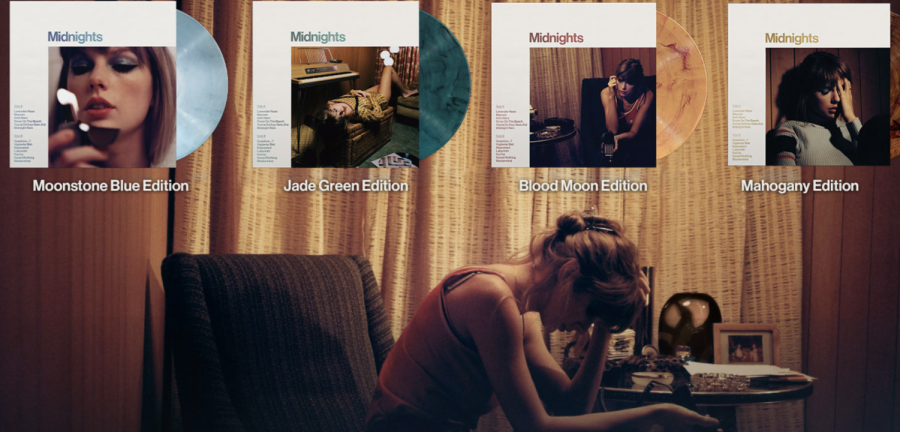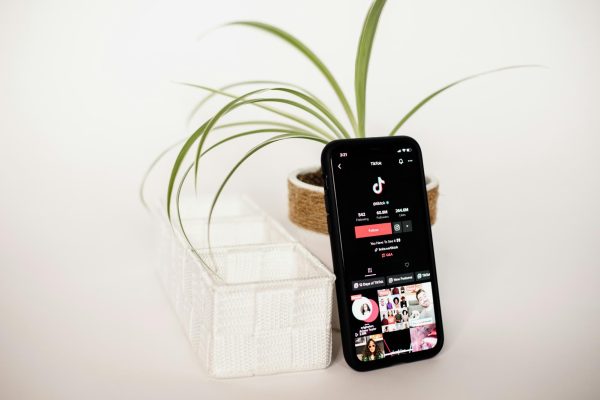“Midnights” Marketing Could Cause Another Upheaval in Vinyl Production
“Midnights” is American singer-songwriter Taylor Swift’s 10th studio album, released on Oct. 21, 2022. The album has since received the utmost praise from numerous outlets, video and written platforms lauding the album for its songwriting, melodies and overall atmosphere. This unique album comes in either the 44 minute standard edition, or the 1 hour and 10 minute long 3am edition. One of the more interesting things behind this album is how Republic Records, Swift’s record label, is promoting it post-launch with Pokémon-like tactics in their CDs, cassette tapes, and vinyl records.
The album was launched on all major streaming platforms: Spotify, Amazon Music, YouTube Music, etc. This was on top of physical variants, including vinyl, cassette and CD. However, the interesting part is how many versions of the variants were released. Going into the Barnes & Noble near the University Mall in Burlington, one can find two copies of the CD, both of which are advertised with “exclusive photos.” This is a fine addition to a limited run variant meant to sell out quickly and only show up on second hand sites. It’s then that the viewer’s attention is drawn to the hype sticker, which states “collect all 4 special editions,” almost like they’re Pokémon cards. Walking over to the vinyl section, one will find something else that awaits them: four variants of the vinyl record. These gorgeous colors include moonstone blue, jade green, blood moon, mahogany, and a Target exclusive lavender marble.
When you turn over these four different vinyls, you also see how the backings all make the visual of a giant clock when all four variants are aligned in the right order. This concept is shared with the CD variant, but the cassette only comes in one moonstone blue color. Then the hype sticker, to which one usually finds that coveted “/1000” number which signifies how many vinyl or CDs were made of that variant and truly defines how rare and limited this version is. This would cause any vinyl junkie to itch something fierce as they throw their card at the cashier, hoping to catch that sweet sweet high of owning something unique and non-reproducible. Looking at this one, however, leaves that junkie low, as one sees that there is no indication of rarity.
Last year, Adele’s record label, Sony Records, caught issue when word spread that they went the old-fashioned route and pre-ordered 500,000 vinyl copies of the album to be pressed, sending out words of sorrow like a plague unto any and all smaller bands hoping to scrounge up enough to have their debut EP or album pressed for the 2021 vinyl market. This issue left the vinyl world spinning. Small bands like Russian doom metal group Pale Keeper at first couldn’t even think of the ability to press a vinyl copy for any of their three EPs that had been released up to that point. This is because time and resources would be first and foremost put towards Adele’s album, as her label must’ve paid out big time for those factories. However, vinyl seemed to rebound, and smaller bands’ production processes were able to return to normal once this issue seemed to fade out; those 500,000 copies were pressed and factories could finally breathe a sigh of relief and work on smaller projects.
The lack of limited variants for Taylor Swift’s album comes at the cost of vinyl production, it can spell another sign of doom for vinyl production as a whole. These variants aren’t just one single color being pressed, they’re marbled, a practice where a solid color of vinyl plastic is sprinkled with small pellets of a different color to achieve an effect similar to marble stone. This process is timely and consumes numerous resources that could be going towards other vinyl but most likely aren’t, since Republic paid enough to be more important than the smaller bands, who simply want a little run of 100 single colored records.
This problem doesn’t seem that crazy now, as the album just came out, but in the future it could cause more issues with the already unsteady supply chain of vinyl production. Pellets, worker time, and factory storage space can easily be eaten up by these four very complex variants. One solution would be to open more vinyl pressing factories, as former White Stripes member Jack White put in an open article and video aimed at the three larger record labels, Warner, Universal and Sony. In it, White speaks from inside Third Man Pressing, a subsidiary of his record label Third Man Records, which is his personal pressing facility that he opened in 2017 with funding coming from his personal account. White, however, is not infallible in the argument of complex records, as he pressed intricate vinyl variants like the independent store exclusive astronomical blue for his album “Fear of the Dawn” and the phenomenal heavenly eclipse variant for “Entering Heaven Alive.” However, White has his own record pressing facility, and he can easily accommodate the resources, people-power and storage needs for pressing large numbers of these records; thus allowing the roughly 30 other pressing plants in the United States to focus on other orders like Billie Eilish’s “Happier Than Ever,” or Olivia Rodrigo’s “SOUR.”
This issue isn’t solely in the pop scene and should not be a part in anyone’s hatred of Swift; as stated before, this is on the part of her record label, Republic Records, who signed off on making these variants unlimited. Other examples of this happening include Slipknot’s “The End So Far,” with nine different CDs being produced with only different cover art and lyric booklets. Another example is Polish extreme metal band Behemoth, and their 15 different vinyl variants for their latest album “Opvs Contra Natvram.”
Looking at this issue, it tells the music world two things: 1. Taylor Swift is a god and should be seen as one, and 2. vinyl production should be treated with dignity and respect. This whole issue doesn’t stem from Swift’s greed, as she is most likely not seeing much profit from vinyl sales. These variants have probably caused numerous audiophiles to flip their lids on Swift as a person, as if she is on her own label and making the decisions, when in reality it can easily be inferred that she had little say in this part of the marketing, as more vinyl means more money.
In conclusion, don’t let this be the deciding factor in whether you buy her new album on all four variants or one. This problem isn’t going to go away anytime soon. It also shouldn’t detract from the fact that the album is an all around knockout of the park and deserves any awards and praise it receives when awards season comes a knockin’ on our doors.





